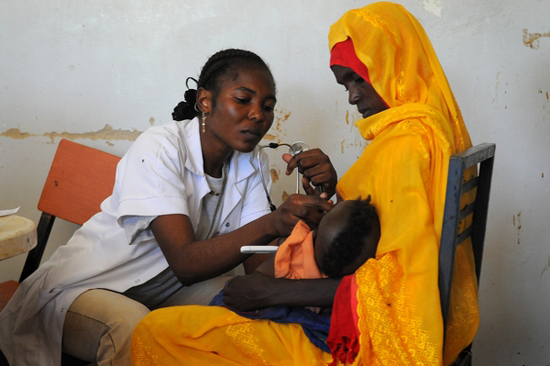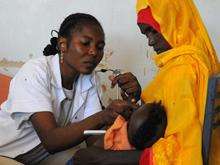MSF doctor Kalyani Gomathinayagam discusses the situation in Biltine, Chad, where MSF is working to nurse acutely malnourished children back to health.

Chad 2012 © Florian Lems
An MSF nurse examines a patient at the ambulatory feeding center in Angara.
Dr. Kalyani Gomathinayagam, from India, runs the Doctrors Without Borders/Médecins Sans Frontières (MSF) nutrition center in Biltine, eastern Chad, where acutely malnourished children in need of intensive care are nursed back to health. Here, she discusses the situation on the ground.
Every year there are families in Biltine who don’t have enough food in the months leading up to the harvest. This year, the crisis was particularly severe. Our emergency program saves lives, but it cannot change the underlying causes of this chronic crisis.
Our mobile teams make daily visits to surrounding villages to treat malnourished children on an outpatient basis, and the most severe cases are brought to the hospital for treatment. The biggest problem—on top of malnutrition—is diarrhea. In Biltine, less than 15 percent of people have access to clean drinking water, and the result can be seen in our program, as more than half of the children suffer from diarrhea. Respiratory infections and malaria are also major problems. For a malnourished child, these diseases can quickly become life-threatening.
Milk Around the Clock
My day at the nutrition center starts at 7:00 am when I examine the children whose conditions may have worsened overnight. We then weigh and measure all the children. I am fortunate to work with a highly motivated team. We have nine Chadian nurses who do shift work, and nine other local employees who have the huge task of providing children with special milk every three hours, day and night. Without this dedicated team working around the clock, we wouldn’t be able to cope.
At the morning meeting we discuss the most important cases, and around 9:30 am the first admissions of the day begin to arrive. The children are often from poor families and they are usually brought to us in the late stages of malnutrition. We examine and register them and then we immediately begin the nutrition program. We treat acutely malnourished children with special milk through a naso-gastric tube. Children with severe diarrhea are rehydrated with intravenous fluids to compensate for fluid loss.
From April to mid-September we treated some 430 children at the hospital. In order to treat them all, and accommodate their mothers as well, we set up large tents in the hospital courtyard. At the end of September—the end of the rainy season and just before the crops were harvested—we admitted 46 new cases.
“It’s Hugely Rewarding When . . . a Child Starts to Smile”
Fortunately, most children who come to us recover very quickly. It is satisfying to see that we can help these young patients so quickly, often with the simplest of tools. The work is stressful, but it's hugely rewarding when a child is strong again and starts to smile.
However, sometimes the children who come to us are so sick that we can no longer help. And if a child dies, the whole team suffers. But parents don’t blame us. Many people here say, "Physicians may be helpful, but they cannot save lives. Only God can."
In the afternoon we hold a group meeting for the mothers. We explain how the nutrition program works, and the importance of outpatient care after their child is released, including the importance of clean drinking water and hygiene to prevent malnutrition and other diseases.
For mothers, it is not easy to have a sick child in the hospital. Who takes care of the other children at home? First they must convince their husbands they need to take the child to hospital—and often the men do not want their wives to be away from home for long. If a parent refuses to have their child treated at the hospital it is hard to accept, but it sometimes happens. I don’t have much time to think about it, because there's always the next emergency; another child who needs help.
Same Time Next Year?
Although we are still treating many children, we realize that our emergency program may end soon. Once the harvest is collected the families will have more to eat, and the peak of this year's food crisis will be over. We will hand over the program to the local health authorities. It won’t be easy, though, because people here have so many other problems. And because we know that it is quite possible that we may be here again next year to treat more acutely malnourished children.




